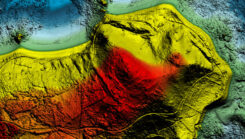Mapping ‘Hell on Earth’

A mapping feature from GPS World magazine’s June issue.

STILL BURNING: This false-color image shows burned areas in yellow and healthy vegetation in purple. The bright spots are where the fire was actively burning when the image was taken. (Image courtesy of DigitalGlobe, © 2016)
The fire swept through Fort McMurray, destroying more than 1,600 homes and buildings and forcing the largest wildfire evacuation in Alberta’s history.
People described it as hell on Earth, comparing the disaster to movies, war, and the apocalypse. By the end of the week, the fire had grown to more than 101,000 hectares, significantly larger than the city of Calgary.

BURN SCAR: On May 4, the Landsat 7 satellite’s Enhanced Thematic Mapper Plus acquired this false-color image combining shortwave infrared, near infrared and green light (bands 5-4-2). Near- and short-wave infrared help penetrate clouds and smoke to reveal hot spots of fire (red), smoke (white) and burned areas (brown).
The entire city population of 88,000 evacuated in a rush, many through falling embers from wildfires beside roadways.
On May 5, DigitalGlobe’s WorldView-3 satellite (WV-3) peered through smoke using shortwave infrared to take the image on the left. GIS analysts can also measure the intensity of the fire using the image.
As of press time, the fires continue to spread across northeast Alberta, impacting Canada’s oil sand operations, and into the neighboring province of Saskatchewan.
The wildfire may become the most costly disaster in Canadian history.

















Follow Us